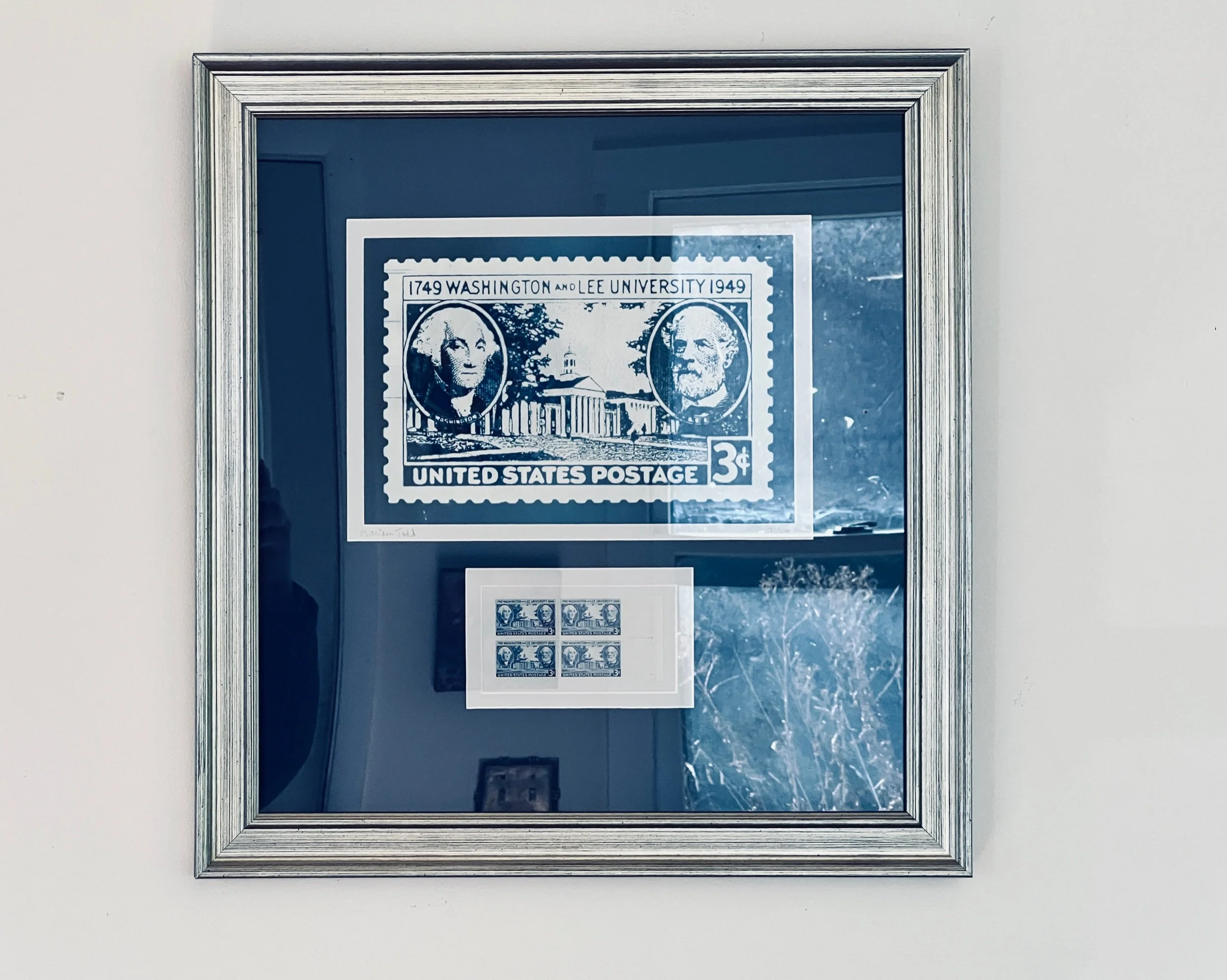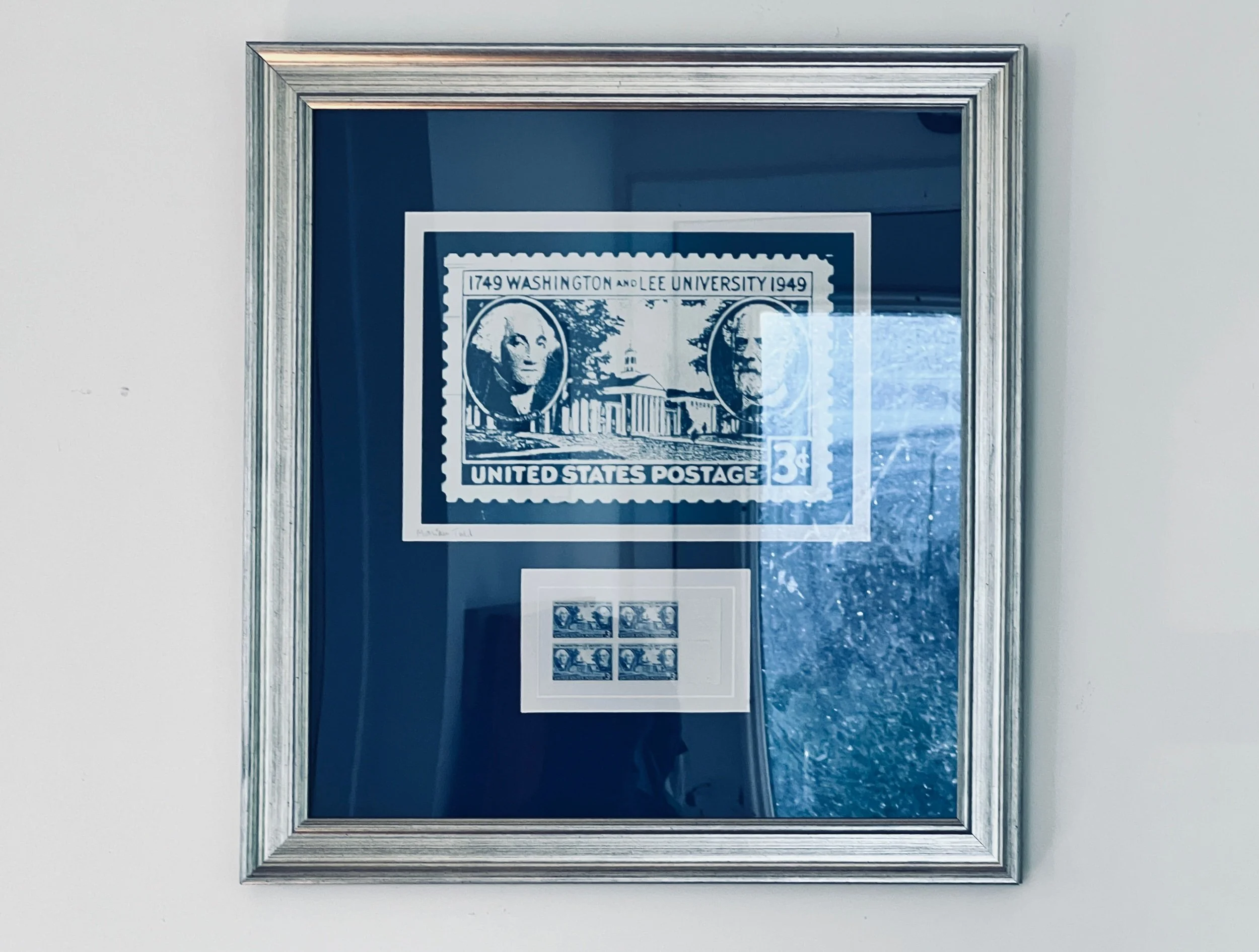 Image 1 of 5
Image 1 of 5

 Image 2 of 5
Image 2 of 5

 Image 3 of 5
Image 3 of 5

 Image 4 of 5
Image 4 of 5

 Image 5 of 5
Image 5 of 5






The Generals: 1949 USPS Commemorative Washington and Lee University Stamp wuth Robert E. Lee, George Washington, and the historic Colonnade Original Cyanotype Art
I couldn't believe it when I found a postage stamp from 1949 featuring both the Generals central to the origins and name of Washington and Lee University on either side of the Colonnade; a central point of W&L’s campus. I used to walk by it daily when we lived in Lexington to meet my husband in the Journalism building and we'd walk home together.
These original handmade cyanotypes were inspired by the 1949 three-cent United States Postal Service stamp commemorating the 200th anniversary of Washington and Lee University. They include stamps from the original 1949 issue. To learn more about the history of the stamp, click here.
A cyanotype is created by exposing a substrate that has been treated with ferric ammonium citrate and potassium ferricyanide to UV light. It is a monochromatic, direct contact photographic process requiring either the use of a negative or the placement of physical specimens, such as plants, directly onto the treated surface.
The process, one of the oldest photographic printing techniques, was discovered by Sir John Herschel in England in 1842. Within a few short years, a friend of the Herschel family, Anna Atkins, used this process to create the first book illustrated with photographs, Photographs of British Algae: Cyanotype Impressions. By 1872, cyanotypes were being used commercially to reproduce architectural and structural blueprints after William Henry Fox Talbot, who himself invented the Calotype, a precursor to the wet collodion process, refined the technique.
All cyanotypes are unique, including those that are derived from negatives. This is due to the variance inherent in any photographic process that must be chemically developed. Differences in tone, saturation, and exposure are expected, and these differences help set each piece apart, making each one its own work of art.
These cyanotypes use 300-gsm, acid-free, cold-pressed archival quality paper. After the works are exposed, they are washed in water, dried, pressed and finished with cold wax. They are matted and shrink wrapped. Each one is made to order using the cyanotype process and takes 2-4 weeks until they are ready to ship.
I offer them matted and shrink wrapped in two sizes, Large and Medium.
I have one ready to ship that is matted and framed to 18 5/8" x 19 3/4"; excuse the glare from the glass in photo!
Make your selection from the dropdown menu below.
I couldn't believe it when I found a postage stamp from 1949 featuring both the Generals central to the origins and name of Washington and Lee University on either side of the Colonnade; a central point of W&L’s campus. I used to walk by it daily when we lived in Lexington to meet my husband in the Journalism building and we'd walk home together.
These original handmade cyanotypes were inspired by the 1949 three-cent United States Postal Service stamp commemorating the 200th anniversary of Washington and Lee University. They include stamps from the original 1949 issue. To learn more about the history of the stamp, click here.
A cyanotype is created by exposing a substrate that has been treated with ferric ammonium citrate and potassium ferricyanide to UV light. It is a monochromatic, direct contact photographic process requiring either the use of a negative or the placement of physical specimens, such as plants, directly onto the treated surface.
The process, one of the oldest photographic printing techniques, was discovered by Sir John Herschel in England in 1842. Within a few short years, a friend of the Herschel family, Anna Atkins, used this process to create the first book illustrated with photographs, Photographs of British Algae: Cyanotype Impressions. By 1872, cyanotypes were being used commercially to reproduce architectural and structural blueprints after William Henry Fox Talbot, who himself invented the Calotype, a precursor to the wet collodion process, refined the technique.
All cyanotypes are unique, including those that are derived from negatives. This is due to the variance inherent in any photographic process that must be chemically developed. Differences in tone, saturation, and exposure are expected, and these differences help set each piece apart, making each one its own work of art.
These cyanotypes use 300-gsm, acid-free, cold-pressed archival quality paper. After the works are exposed, they are washed in water, dried, pressed and finished with cold wax. They are matted and shrink wrapped. Each one is made to order using the cyanotype process and takes 2-4 weeks until they are ready to ship.
I offer them matted and shrink wrapped in two sizes, Large and Medium.
I have one ready to ship that is matted and framed to 18 5/8" x 19 3/4"; excuse the glare from the glass in photo!
Make your selection from the dropdown menu below.